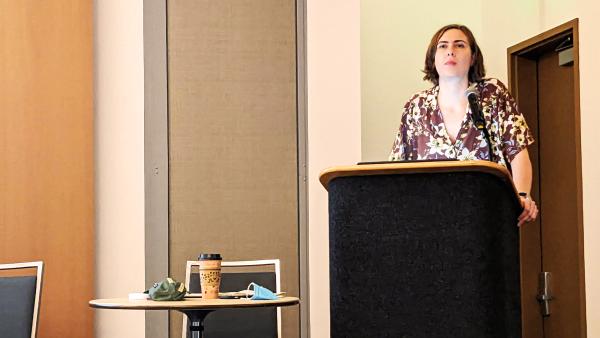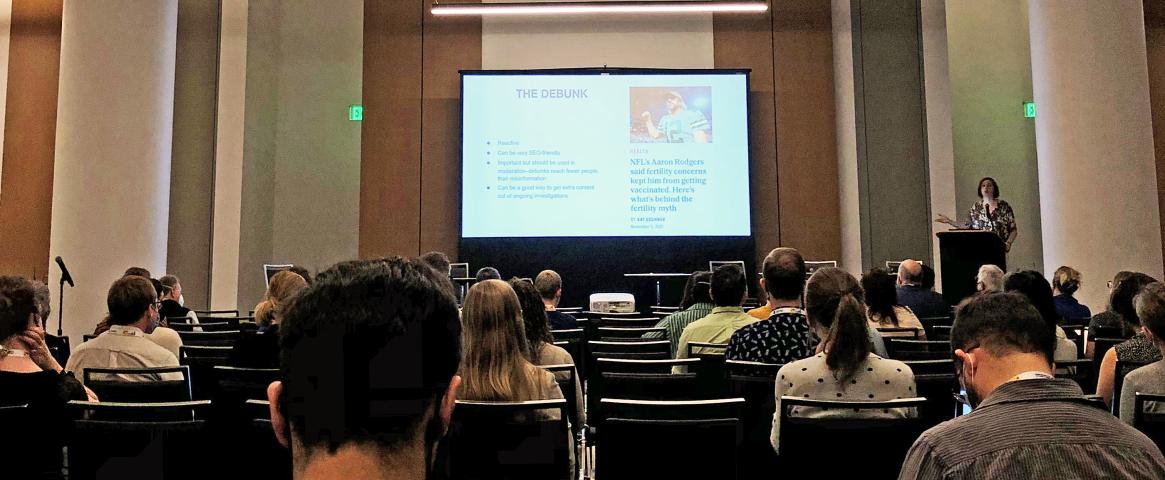Story by Andrew Meissen
Photography by David Jen and Ben Young Landis
The key to correcting misinformation is to debunk it quickly, and ideally prebunk it before it even sprouts. At the ScienceWriters2022 national meeting in Memphis, journalist Kat Eschner taught attendees multiple tools for writing different types of stories to combat misinformation, in a session titled “Beyond Fake News: Reporting on Misinformation” (#ReportingFakeSci).
An affordability reporter at AVO based in Toronto, Eschner educated the crowd about three types of misinformation stories they can report: “The Debunk, the Prebunk, and the Follow the Money.”
- Highlights from Escher’s #ReportingFakeSci workshop (Google Slides)
In the debunk, a reporter acknowledges false information that is spreading and instead provides the truth. It is reactive to existing misinformation, often pegged to the news. When acknowledging misinformation, it is extremely important for a reporter to provide the truth as quickly as possible, such as in the same sentence they introduced the misinformation, so as to prevent that misinformation from accidentally seeding in the reader. In all cases of the debunk, the reporter must also move quickly to produce the story, Eschner said, as misinformation spreads quickly.
Eschner elaborated that misinformation spreads easily for reasons that a newsroom can relate to. Misinformation is usually grounded in an important current event; it is timely. Misinformation often appeals to existing biases; it is relatable. The content is often emotionally provocative and striking in its imagery; it is clickable.
"These are some of the basic tactics that journalists use to share their own information, too," Eschner said. But journalists are beholden to the truth, while those sharing misinformation are not. "Good journalists use these tactics in a different way. It’s not as successful, and it doesn’t share as far, because they're not able to get the sugar rush of pure fake information that just hits you really hard."
 Kate Escher organized and led the #ReportingFakeSci workshop at ScienceWriters2022 in Memphis. (David Jen for NASW)
Kate Escher organized and led the #ReportingFakeSci workshop at ScienceWriters2022 in Memphis. (David Jen for NASW)
The prebunk story is like a vaccine against incoming misinformation. It is proactive. The prebunk prepares readers with genuine information as well as the ability to spot the exact misinformation that may be coming their way. Given this requires foresight from a reporter, they can use a few tools. Eschner recommended looking at Google Trends to see what people are searching; reviewing a reporter’s own analytics to see what stories are most-read; and asking sources if they’ve been hearing about any misinformation.
Reporters should keep in mind that successful prebunking often makes the reporter and their news organization the go-to source for combatting that realm of misinformation. Given that prebunking stories are cheap to produce, sometimes requiring only a single 20-minute phone call with an expert and a couple hours of writing, it is an effective way for a reporter to develop a beat while doing a massive service to their audience.
Reporters can also consider follow-the-money stories, which are investigative, aimed at revealing the actors and beneficiaries behind false information. It asks: why are people spreading this misinformation? Given the required endurance and possibly overwhelming nature of working on an investigative piece, Eschner recommended keeping an eye out for misinformation regularly, say by writing debunks or prebunks, before working on a follow-the-money story.
"It really pays to start investing in the habit of monitoring false information, so that when you go to investigate these stories, it isn’t all new."
Eschner also offered numerous other tips to reporters about misinformation. Reporters should understand that most misinformation is not maliciously spread; it is often without the intent to harm or gain benefit. Likewise, a reporter should know that expert sources are also vulnerable to misinformation; everyone is human, and expertise does not always inoculate them from absorbing misinformation.
Importantly, all writers and editors should be careful not to talk down to their audiences — even if an expert does by saying something like "I don’t know how anyone believes this," as research shows belittlement causes the audience to double-down on their misinformed beliefs. Lastly, know that many people have good reasons for distrusting genuine information and believing false information, such as marginalized groups distrusting medical establishments that have historically harmed them, or climate change deniers finding relief in not carrying the dread of an existential threat.
Early on in her COVID-19 reporting, Eschner interviewed the CDC about addressing the blooming misinformation crisis. “I asked one question. What’s the plan?” Her source said: “We rely on you guys for that.” Although journalists are not the only ones who must combat misinformation, it is a crucial responsibility journalists hold. Beholden to the truth, journalists have the power to correct false narratives for the betterment of the world.
Andrew Meissen (@AndrewMeissen) is a freelance science journalist reporting on mental health, neuroscience, tech, and other topics. He is also a past recipient of the NASW Diversity Reporting Grant.
David Jen (@djenwrites) is a freelance journalist covering climate, energy, and local government.
This ScienceWriters2022 conference coverage article was produced as part of the NASW Conference Support Grant awarded to Meissen and Jen to attend the ScienceWriters2022 national conference. Find more 2022 conference coverage at www.nasw.org
A co-production of the National Association of Science Writers (NASW), the Council for the Advancement of Science Writing (CASW), and St. Jude Children's Research Hospital, the ScienceWriters2022 national conference featured an online portion Oct. 12-19, followed by an in-person portion held in Memphis, Tenn. Oct. 21-25. Learn more at www.sciencewriters2022.org and follow the conversation on Twitter at #SciWri22
Credits: Reporting by Andrew Meissen; edited by Ben Young Landis. Photography by David Jen; edited by Ben Young Landis




